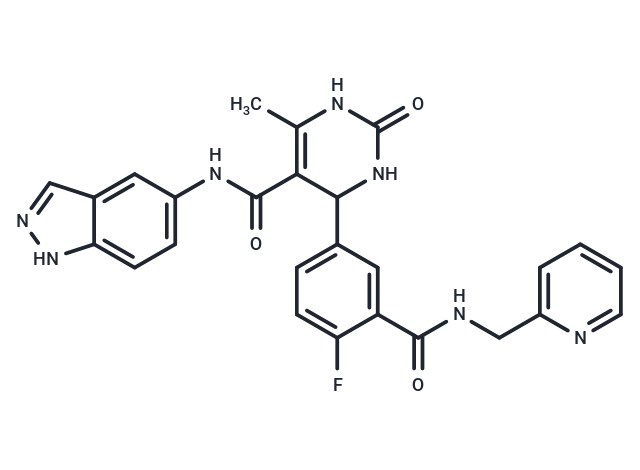Shopping Cart
- Remove All
 Your shopping cart is currently empty
Your shopping cart is currently empty

CCG215022 is a G protein-coupled receptor kinases (GRKs) inhibitor with IC50s of 0.15±0.07 μM for GRK2, 0.38±0.06 μM for GRK5, and 3.9±1 μM for GRK1.

| Pack Size | Price | Availability | Quantity |
|---|---|---|---|
| 1 mg | $97 | In Stock | |
| 2 mg | $143 | In Stock | |
| 5 mg | $247 | In Stock | |
| 10 mg | $397 | In Stock | |
| 25 mg | $663 | In Stock | |
| 50 mg | $945 | In Stock | |
| 100 mg | $1,280 | In Stock | |
| 500 mg | $2,570 | In Stock | |
| 1 mL x 10 mM (in DMSO) | $272 | In Stock |
| Description | CCG215022 is a G protein-coupled receptor kinases (GRKs) inhibitor with IC50s of 0.15±0.07 μM for GRK2, 0.38±0.06 μM for GRK5, and 3.9±1 μM for GRK1. |
| Targets&IC50 | GRK1:3.9±1 μM, GRK2:0.15±0.07 μM, GRK5:0.38±0.06 μM |
| In vitro | CCG215022 demonstrates nanomolar potency against both GRK2 and GRK5, outperforming Paroxetine by being at least 20-fold more potent. A GRK2 structure-based drug design campaign revealed CCG215022's nanomolar IC50 values against GRK2 and GRK5, alongside significant selectivity over other closely related kinases, including GRK1 and PKA. When applied to murine cardiomyocytes, CCG215022 significantly enhances contractility at concentrations 20-fold lower than those required for Paroxetine, which exhibits modest selectivity for GRK2[1]. |
| Kinase Assay | GRK5 and urea-washed bovine rod outer segments (ROS) are mixed in the dark in buffer containing 20 mM HEPES, pH 7.5, 4 mM MgCl2, and 2 mM EDTA and incubated for 35 min at room temperature. The reaction mixtures are exposed to ambient fluorescent light for 1 min prior to initiation of the reaction by addition of ATP (with [γ-32P]ATP) to a final concentration of 1 mM. Final concentration of GRK5 is 100 nM and ROS is between 0.75 and 24 μM. Reactions are initiated at room temperature, and samples are taken at 2-5 min and then quenched with SDS-PAGE loading dye. Proteins are separated using SDS-PAGE, gel is dried, and the incorporation of γ-32P is detected using a phosphor storage screen. Rates at 0 min are plotted against the ROS concentration, and Vmax and Kmvalues are determined using the Michaelis-Menten equation. Vmax of each curve is normalized to the Vmax of GRK5561 run in parallel. Melting point determinations in response to 200 μM CCG215022 are performed in 20 mM HEPES, pH 7.0, 5 mM MgCl2, 2 mM DTT, 1 mM CHAPS at a final GRK5 concentration of 0.2 mg/mL and 100 μM anilinonaphthalene-8-sulfonic acid using a ThermoFluor plate reader. Melting points of GRK5 variants are assayed in a buffer containing 20 mM HEPES, pH 8.0, 200 mM NaCl, 2 mM DTT, 2.5 mM MgCl2, and 0.1 mM anilinonaphthalene-8-sulfonic acid with or without 5 mM ATP. Final GRK5 concentration for these assays is 0.1 mg/mL[1]. |
| Molecular Weight | 499.5 |
| Formula | C26H22FN7O3 |
| Cas No. | 1813527-81-9 |
| Smiles | CC1=C(C(NC(=O)N1)c1ccc(F)c(c1)C(=O)NCc1ccccn1)C(=O)Nc1ccc2[nH]ncc2c1 |
| Relative Density. | 1.422 g/cm3 (Predicted) |
| Storage | Powder: -20°C for 3 years | In solvent: -80°C for 1 year | Shipping with blue ice. | |||||||||||||||||||||||||||||||||||
| Solubility Information | DMSO: 50 mg/mL (100.1 mM), Sonication is recommended. | |||||||||||||||||||||||||||||||||||
Solution Preparation Table | ||||||||||||||||||||||||||||||||||||
DMSO
| ||||||||||||||||||||||||||||||||||||

Copyright © 2015-2025 TargetMol Chemicals Inc. All Rights Reserved.